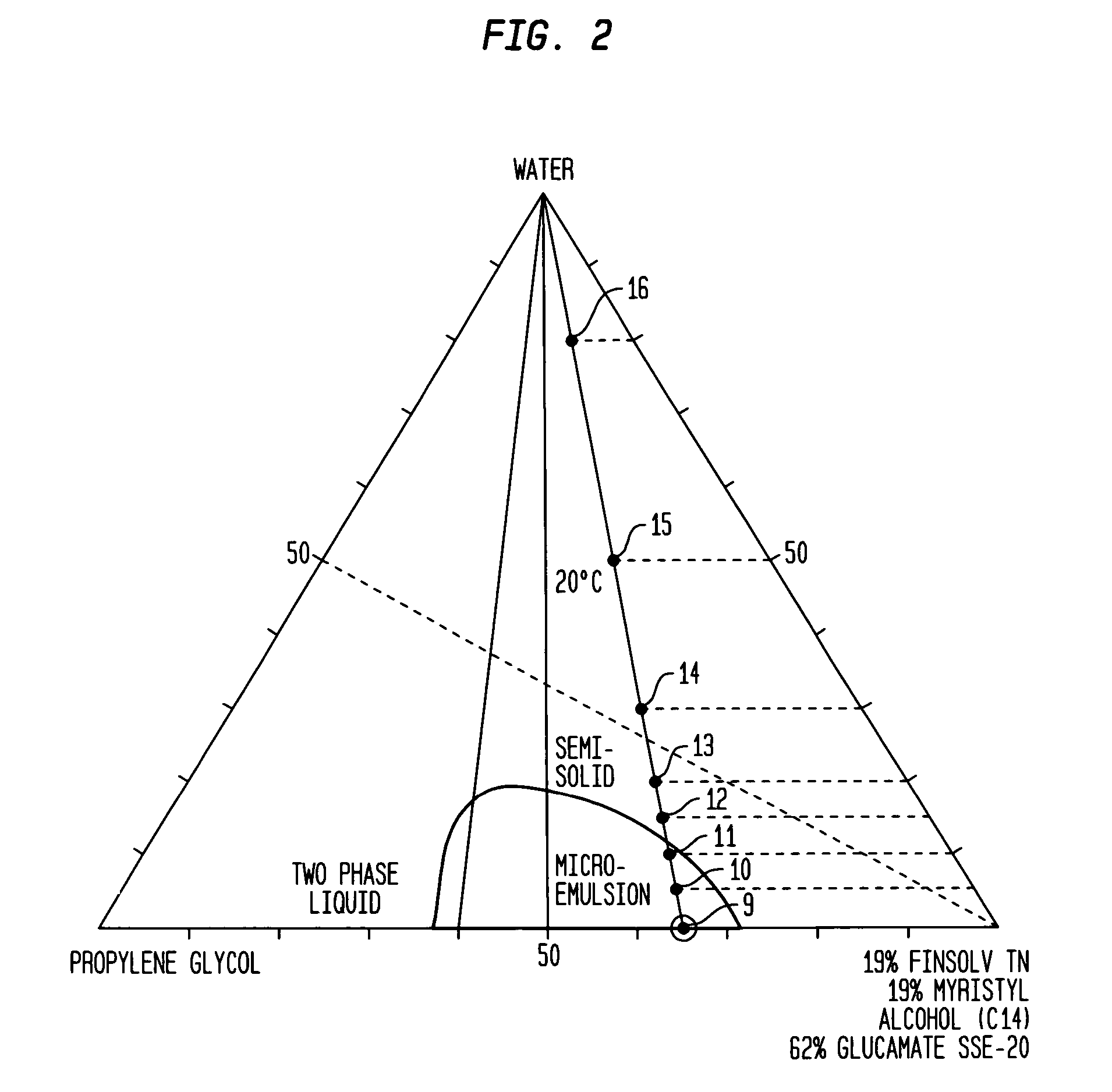Lotion-treated tissue and towel
a technology of paper towels and lotions, applied in the field of paper towels, can solve the problems of affecting the production rate of lotions, affecting so as to improve the converting process and production rate, and prevent the adhesion of “stickies”
- Summary
- Abstract
- Description
- Claims
- Application Information
AI Technical Summary
Benefits of technology
Problems solved by technology
Method used
Image
Examples
examples
[0046]Formulations of the waterless lotion of the present invention were prepared in which, the components, their ratios and the conditions selected to provide micro-emulsion subject to in-situ phase change upon contact with a cellulosic substrate were varied as shown in the following Examples.
[0047]In preparing each formulation the following, a general procedure was used. The polar phase propylene glycol was mixed with surfactant and co-surfactant in a heated container at about 60° C. to about 70° C. until the chemicals were completely melted. The non-polar oil phase was added to the mixture with moderate agitation for about 10 minutes, then cooled to room temperature. At this point the lotion was in clear liquid form and ready to apply to the substrate. The micro-emulsion formed spontaneously without the need for a high shear mechanical device and is stable indefinitely.
examples 1-7
[0048]Examples 1 to 7 were prepared in accordance with the present invention.
[0049]These lotion formulas were liquid at room temperature, transparent, very stable and accordingly the lotion ingredient ratios were inside the micro-emulsion region of phase diagrams such as FIG. 1 which is a partial phase diagram of the composition of Example 1. Surprisingly, the lotion of the present invention is characterized as having a good hand-feel perception and non-greasy hand-feel, which is thought to be due to the particle size of the micro-emulsion being too small to be detected in the oil phase by the fingertips.
[0050]
TABLE 1Ex. 1Ex. 2Ex. 3Ex. 4Ex. 5Ex. 6Ex. 7Ingredients(%)(%)(%)(%)(%)(%)(%)Propylene glycol3535515153035Finsolv TN(1)12.5016030150Carnation oil(2)00000012.5Isopropyl myristate015030000Lambert CE 2000(3)0040000Myristyl12.515000012.5alcohol(C14)Kalcol 1618(4)007.505.55.50Glucam P-200067.5049.549.50Distearate(5)Glucamate SSE-20(6)40350550040(1)Finsolv TN: C12-C15 alkyl benzoate es...
example 8
[0051]The lotion prepared in Example 1 was applied to a tissue basesheet at a 5% add-on level, then converted to a two ply tissue product. The product was tested for the amount of lotion transferred to the skin. The results were compared with commercially available lotioned tissues by comparing the light reflection of cold lotion residual on glass relative to that from two other products. The scattering of light caused by lotion smeared onto the glass microscope slide was measured by using the UV / visible spectrophotometer in the wavelength region from 700 nm to 400 nm. Lotion was transferred to the slide by holding it between two layers of lotioned tissue for 30 seconds and then rubbing the tissue over the slide 20 times in 15 seconds. The lotion smeared glass slide was placed in the sample beam of a double beam UVNisible spectrometer to measure the light scattering. The results show that scattering of light caused by lotion smeared onto the slide rubbed with the tissue treated with...
PUM
| Property | Measurement | Unit |
|---|---|---|
| temperature | aaaaa | aaaaa |
| particle size diameter | aaaaa | aaaaa |
| particle size diameter | aaaaa | aaaaa |
Abstract
Description
Claims
Application Information
 Login to View More
Login to View More - R&D
- Intellectual Property
- Life Sciences
- Materials
- Tech Scout
- Unparalleled Data Quality
- Higher Quality Content
- 60% Fewer Hallucinations
Browse by: Latest US Patents, China's latest patents, Technical Efficacy Thesaurus, Application Domain, Technology Topic, Popular Technical Reports.
© 2025 PatSnap. All rights reserved.Legal|Privacy policy|Modern Slavery Act Transparency Statement|Sitemap|About US| Contact US: help@patsnap.com


